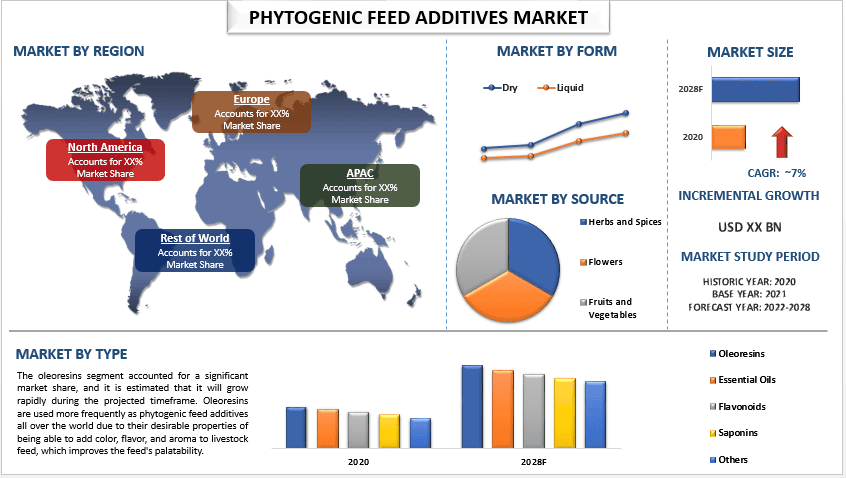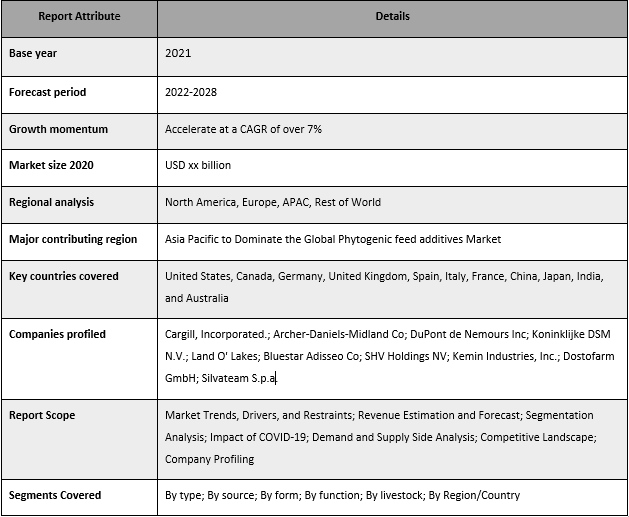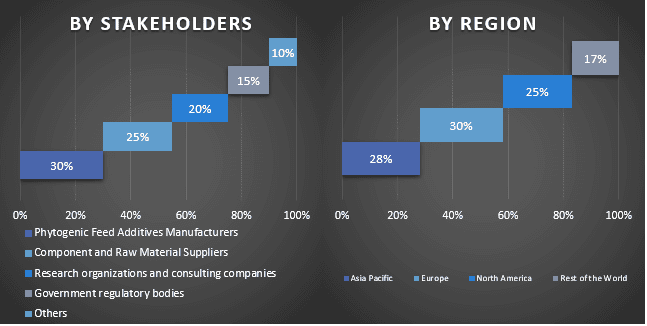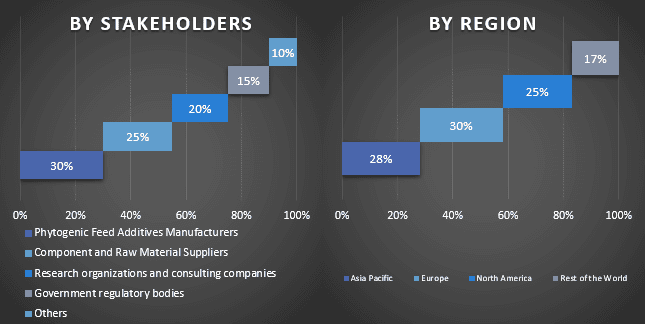Emphasis on Type (Essential Oils, Flavonoids, Saponins, Oleoresins, Others); Source (Herbs and Spices, Flowers, Fruits and Vegetables); Form (Liquid, Dry); Function (Performance Enhancers, Antimicrobial Properties, Palatability Enhancers, Others); Livestock (Poultry, Swine, Ruminants, Aquatic animals, Others); and Region/Country

The phytogenic feed additives market is expected to register a CAGR of approx. 7% over the period of 2022-2028. Phytogenic is a naturally occurring growth promoter. Phytogenic has numerous benefits for modern livestock production, including antioxidative, anti-microbial, anti-inflammatory, and digestion-enhancer properties. To encourage growth, they are included in the feed for animals. Phytogenic has gained popularity over conventional feed additives because they are all-natural and free of antibiotics. Phytogenic additives help with digestion while improving the flavour of the feed. Certain herbs, spices, and oils, specifically lemon and caraway oil, contain phytogenic compounds that aid in the growth of certain animals. The growing demand for phytogenic feed additives can be attributed to the rising fortification of phytogenics in bovine feed on account of adding flavor and inducing high feed intake for growth and reproductive performance which boosts the adoption of organic growth strategies among key industry players around the globe. For instance, in January 2020, Kemin Industries introduced VANNIXTM C4, a new phytogenic feed additive that complements Kemin Animal Nutrition and Health – North America’s full portfolio of poultry gut health products. VANNIX C4 is a formulation of gut-health-fortifying ingredients that are designed as a cost-effective solution for producers. These products are to promote a healthy intestinal microbial balance and support the overall performance of the animal. Owing to the glaring statistics due to the rising awareness about animal health & feed quality help to boost the phytogenic feed additives market across the globe and would contribute to the growth of the market in the forthcoming period as well. Furthermore, the phytogenic feed additives market is anticipated to grow on account of the rising importance of improving feed quality and preventing poultry diseases. In addition, increased demand for livestock products and the ban on antibiotics as growth promoter drives the market growth. However, some of the restraints in the market including the high cost of natural feed additives and the complex composition of phytogenic compounds are impeding the growth of this market all over the world.
Cargill, Incorporated.; Archer-Daniels-Midland Co; DuPont de Nemours Inc; Koninklijke DSM N.V.; Land O’ Lakes; Bluestar Adisseo Co; SHV Holdings NV; Kemin Industries, Inc.; Dostofarm GmbH; Silvateam S.p.a. are some of the key players in the market. Several M&As along with partnerships have been undertaken by these players to facilitate customers with hi-tech and innovative products/technologies.
Insights Presented in the Report
“Amongst type, the oleoresins segment accounted for a significant market in 2020”
Based on the type, the phytogenic feed additives market is segmented into essential oils, flavonoids, saponins, oleoresins, and others. The oleoresins segment accounted for a significant market share, and it is estimated that it will grow rapidly during the projected timeframe. Oleoresins are used more frequently as phytogenic feed additives all over the world due to their desirable properties of being able to add colour, flavour, and aroma to livestock feed, which improves the feed’s palatability. As their consumption and acceptance continue to rise over the forecasted period, the oleoresins are likely to experience significant growth.
“Amongst source, the fruits and vegetable segment accounted for a significant market in 2020”
Based on the source, the market is fragmented into herbs and spices, flowers, fruits and vegetables. The fruits and vegetables segment accounted for a significant market share and it is estimated that it will grow rapidly during the projected timeframe. Waste from fruits and vegetables is used specifically in phytogenic feed additives for sustainability, and it also addresses the problems of waste recycling and waste reduction. Additionally, fruits and vegetables like berries, citrus fruits, and onions are used as sources to extract essential oils, flavonoids, and saponins, and their oils are thought to be an excellent phytogenic additive which propels their demand and market growth in the industry.
Phytogenic feed additives Market Report Coverage

“Amongst form, the dry segment accounted for a significant market in 2020”
Based on the form, the market is fragmented into liquid and dry. The dry segment accounted for a significant market share and it is estimated that it will grow rapidly during the projected timeframe. The dry market is increasingly used and accepted by consumers because it is thought to be simpler to use and handle. Due to their increased nutrient digestibility and decreased feed wastage, the powdered form of the dry segment is also more cost-effective and is expected to experience significant demand and growth over the foreseeable future.
“Amongst function, the antimicrobial properties segment accounted for a significant market in 2020”
Based on the function, the market is fragmented into performance enhancers, antimicrobial properties, palatability enhancers, and others. The antimicrobial properties segment accounted for a significant market share and it is estimated that it will grow rapidly during the projected timeframe. The antiviral and antimicrobial properties of phytogenic feed additives account for a large portion of their use in feed products. The main functions of phytogenic feed additives are pathogen control and modulation of intestinal microbiota. They are regarded as a good substitute for antibiotic growth promoters because they have potent antimicrobial and antifungal properties. Over the anticipated period, the market growth and demand for phytogenic feed additives are likely to be influenced by these favourable characteristics.
“Amongst livestock, the swine category is expected to witness considerable CAGR during the forecast period”
Based on livestock, the market is fragmented into poultry, swine, ruminants, aquatic animals, and others. The swine segment grabbed a considerable market share, and it is expected to grow at a significant CAGR during the forecast period. The growth and use of feed phytogenic products in swine has been aided by the sharp rise in the consumption of pork and other swine products in recent years. The use of phytogenic feed intakes in swine for a variety of purposes, including increasing feed intake, enhancing gut function, and boosting disease resistance, has significantly fueled the market growth for these products in recent years.
“Asia Pacific to witness significant growth during the forecast period”
For a better understanding of the market adoption of phytogenic feed additives, the market is analyzed based on its worldwide presence in the countries such as North America (U.S., Canada, and Rest of North America), Europe (Germany, France, Italy, Spain, U.K, and Rest of Europe), Asia-Pacific (China, Japan, India, Australia, and Rest of APAC), and Rest of World. Asia Pacific constitutes a major market for the phytogenic feed additives industry this is due to the lack of harmful residues in plant-based additives. Additionally, the replacement strategies for antibiotic growth promoters are likely to aid the market growth in this region. Furthermore, an increasing number of feed mills and feed production, greater demand for feed, and a rise in awareness about the need for quality feed among livestock farmers are boosting the growth of the market.
Reasons to buy this report:
Customization Options:
Global phytogenic feed additives market can further be customized as per the requirement or any other market segment. Besides this, UMI understands that you may have your own business needs, hence feel free to connect with us to get a report that completely suits your requirements.
1. Market Introduction
2. Research Methodology Or Assumption
3. Market Synopsis
4. Executive Summary
5. Impact Of Covid-19 On The Phytogenic Feed Additives Market
6. Global Phytogenic Feed Additives Market Revenue, 2020-2028f
7. Market Insights By Type
8. Market Insights By Source
9. Market Insights By Form
10. Market Insights By Function
11. Market Insights By Livestock
12. Market Insights By Region
13. Phytogenic Feed Additives Market Dynamics
14. Phytogenic Feed Additives Market Opportunities
15. Phytogenic Feed Additives Market Trends & Insights
16. Demand And Supply Side Analysis
17. Value Chain Analysis
18. Pricing Analysis
19. Strategic Insights
20. Competitive Scenario
21. Company Profiled
22. Disclaimer
Research Methodology for the Global Phytogenic Feed Additives Market Analysis
(2022-2028)
Analyzing the historical market, estimation of the current market, and forecasting the future market of the global phytogenic feed additives market were the three major steps undertaken to create and analyze the adoption of phytogenic feed additives in major regions globally. Exhaustive secondary research was conducted to collect the historical market numbers and estimate the current market size. Secondly, to validate these insights, numerous findings and assumptions were taken into consideration. Moreover, exhaustive primary interviews were also conducted, with industry experts across the value chain of the global phytogenic feed additives market. Post assumption and validation of market numbers through primary interviews, we employed a top-down/bottom-up approach to forecasting the complete market size. Thereafter, market breakdown and data triangulation methods were adopted to estimate and analyze the market size of segments and sub-segments the industry pertains to. Detailed methodology is explained below:
Analysis of Historical Market Size
Step 1: In-Depth Study of Secondary Sources:
Detail secondary study was conducted to obtain the historical market size of the phytogenic feed additives market through company internal sources such as annual report & financial statements, performance presentations, press releases, etc., and external sources including journals, news & articles, government publications, competitor publications, sector reports, third-party database, and other credible publications.
Step 2: Market Segmentation:
After obtaining the historical market size of the phytogenic feed additives market, we conducted a detailed secondary analysis to gather historical market insights and share for different segments & sub-segments for major regions. Major segments included in the report as the type, source, form, function, and livestock. Further country-level analyses were conducted to evaluate the overall adoption of testing models in that region.
Step 3: Factor Analysis:
After acquiring the historical market size of different segments and sub-segments, we conducted a detailed factor analysis to estimate the current market size of the phytogenic feed additives market. Further, we conducted factor analysis using dependent and independent variables such as the rising fortification of phytogenic in bovine feed, etc. globally. A thorough analysis was conducted for demand and supply-side scenarios considering top partnerships, mergers and acquisitions, business expansion, and product launches in the phytogenic feed additives market sector across the globe.
Current Market Size Estimate & Forecast
Current Market Sizing: Based on actionable insights from the above 3 steps, we arrived at the current market size, key players in the global phytogenic feed additives market, and market shares of the segments. All the required percentage shares split, and market breakdowns were determined using the above-mentioned secondary approach and were verified through primary interviews.
Estimation & Forecasting: For market estimation and forecast, weights were assigned to different factors including drivers & trends, restraints, and opportunities available for the stakeholders. After analyzing these factors, relevant forecasting techniques i.e., top-down/bottom-up approach was applied to arrive at the market forecast about 2028 for different segments and sub-segments across the major markets globally. The research methodology adopted to estimate the market size encompasses:
Market Size and Share Validation
Primary Research: In-depth interviews were conducted with the Key Opinion Leaders (KOLs) including Top Level Executives (CXO/VPs, Sales Head, Marketing Head, Operational Head, and Regional Head, Country Head, etc.) across major regions. Primary research findings were then summarized, and statistical analysis was performed to prove the stated hypothesis. Inputs from primary research were consolidated with secondary findings, hence turning information into actionable insights.
Split of Primary Participants in Different Regions

Market Engineering
Data triangulation technique was employed to complete the overall market estimation and to arrive at precise statistical numbers of each segment and sub-segment of the global phytogenic feed additives market. Data was split into several segments & sub-segments post studying various parameters and trends in the areas of type, source, form, function, and livestock in the global phytogenic feed additives market.
The main objective of the Global Phytogenic feed additives Market Study
The current & future market trends of the global phytogenic feed additives market were pinpointed in the study. Investors can gain strategic insights to base their discretion for investments on the qualitative and quantitative analysis performed in the study. Current and future market trends determined the overall attractiveness of the market at a regional level, providing a platform for the industrial participant to exploit the untapped market to benefit as a first-mover advantage. Other quantitative goals of the studies include:

Customers who bought this item also bought